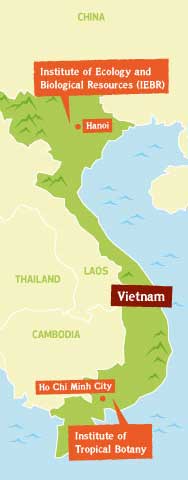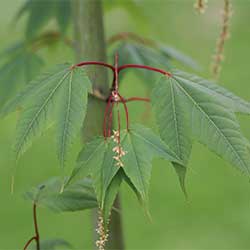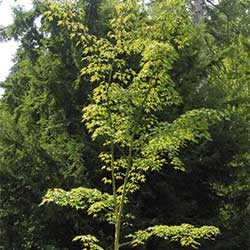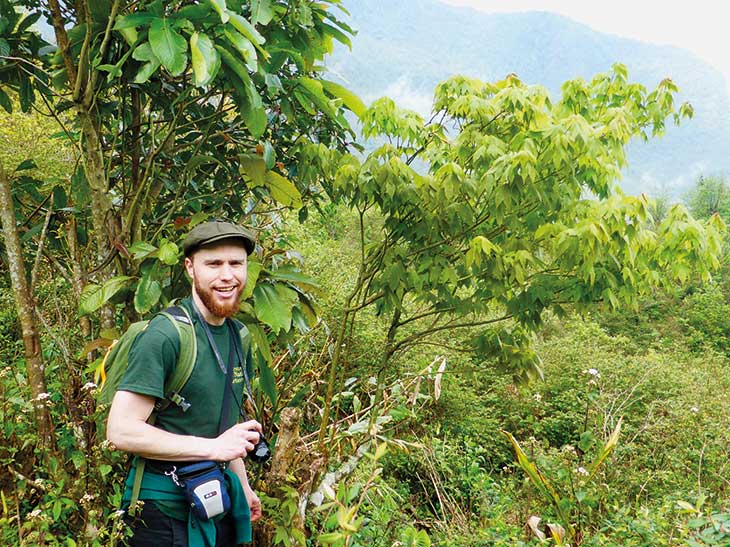Return to Vietnam
In December last year, Dan returned to Vietnam to visit the herbarium at the Institute of Ecology and Biological Resources (IEBR) in Hanoi and the herbarium of the Institute of Tropical Botany in Ho Chi Minh City.

Read about Dan's findings and a fascinating riddle he solved!
The Hoang Lien Son Conservation Initiative (HLSCI) is a multi-institutional conservation project aimed at understanding and conserving the flora of this region of north west Vietnam. In December 2017, I made my second visit to Vietnam to study the maples (Acer) native to the region as part of HLSCI. I had been asked to determine the identification of the maple specimens held in the herbarium at the Institute of Ecology and Biological Resources (IEBR) in Hanoi and I also took this opportunity to study the maple specimens held at the herbarium of the Institute of Tropical Botany in Ho Chi Minh City, where many of the type specimens of species described from Vietnam are held.
The herbarium
This study period also served to inform future fieldwork in the region. From information gleaned from herbarium records, we now know more about which areas should be specifically targeted in our efforts to better understand the genus Acer and its associates in Vietnam and neighbouring areas.
The herbarium at the IEBR holds around 700,000 specimens and, along with the herbarium at the Institute of Tropical Botany, is one of the most important herbaria in Vietnam. The collections made on previous fieldwork in Vietnam as part of the HLSCI, as well as that of other partners, are held here.
"At Ho Chi Minh, my study of the type specimens of Acer species held there proved to be very productive."
There are numerous highlights among the maples held in the herbarium. Acer davidii is one such example as, although this species is well known and widespread in China, it is not well recorded in Vietnam and is currently absent from published floras. A number of species are also notable for their absence from the herbarium. A. chapaense and A. fenzelianum, both described from the Hoang Lien Mountains, are entirely absent and future work will seek to collect these for accession into the collection. Their distributions are not well known, though both are evidently rare and A. fenzelianum has been assessed as Endangered for the IUCN Red List of Threatened Species.

A close up of Acer aff. pectinatum leaves
A riddle uncovered
At Ho Chi Minh, my study of the type specimens of Acer species held there proved to be very productive. Prior to my visit I was most keen to find the type of A. campbellii var.fantsipanense, a tree whose name is a little obscure, and actually invalid under the International Code of Botanical Nomenclature – the set of rules that dictate how plants are named. Plants of a snake bark maple which is not closely related, collected in the Hoang Lien Mountains, have been grown in gardens under this name. This has caused confusion as Acer campbellii is quite different from the group of maples known as the snake barks. We have a fine example of the plant in question along Willesley Drive in Silk Wood (31.1382).
The herbarium at the IEBR holds around 700,000 specimens...
and along with the herbarium at the Institute of Tropical Botany is one of the most important herbaria in Vietnam.
Before my visit to the herbarium in Ho Chi Minh, I had assumed that those calling the plant A. campbellii var. fantsipanense had been confusing the characters between different sections of Acer. As it turns out, it was F. Gagnepain, who described the species in the mid-20th century, who was confused. He had described this snake bark maple as a variety of an altogether different species of maple! Technically, those who had been calling the snake bark from Fansipan Acer campbellii var. fantsipanense were in fact correct, it is just that it should never been called that in the first place. A riddle (partly) solved!

Our fine example of Acer aff. pectinatum growing along Willesley Drive in Silk Wood.
I say partly, as for what this snake bark should actually be called is another matter. It is closely related to Acer pectinatum (comprising of two subspecies), though differs most obviously from this species in its virtually hairless leaf under surfaces.
For now, Acer aff. pectinatum is the most helpful option. As ever, there is more work to do!
